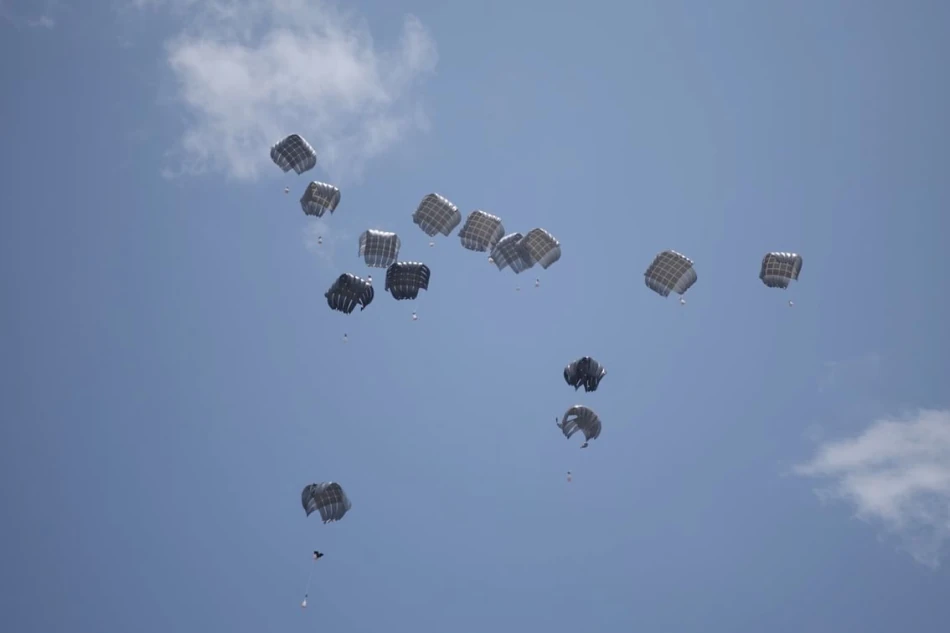
UAE Airlifts 66th Batch of Aid to Gaza Under 'Planes of Goodness' Operation
UAE Delivers 66th Humanitarian Airdrop to Gaza as International Coalition Expands Relief Efforts
The United Arab Emirates has completed its 66th humanitarian airdrop over Gaza, marking a significant milestone in sustained international relief efforts that have now delivered over 3,873 tons of aid to the besieged territory. The operation, conducted through the "Birds of Goodness" initiative under "Operation Gallant Knight 3," demonstrates how middle powers are increasingly coordinating multilateral humanitarian responses in conflict zones where traditional ground access remains severely limited.
Multinational Coalition Takes Shape
The latest airdrop showcased an expanding international partnership, with the UAE working alongside Jordan as the primary regional partner, while European nations Germany, Belgium, France, the Netherlands, and Italy contributed aircraft and supplies. This coalition represents a pragmatic approach to humanitarian delivery that bypasses the complex ground-level logistics that have plagued Gaza relief efforts for months.
The operation specifically targeted hard-to-reach areas within Gaza, focusing on food supplies and essential humanitarian materials for families cut off from conventional aid distribution networks. This tactical approach reflects lessons learned from previous humanitarian crises where aerial delivery proved most effective in reaching isolated populations.
Strategic Implications for Regional Diplomacy
UAE's Humanitarian Leadership
The UAE's sustained commitment to this operation—now spanning 66 separate airdrops—signals a broader shift in Gulf state foreign policy toward visible humanitarian leadership. Unlike previous regional crises where Gulf nations primarily provided financial support, the UAE has positioned itself as an operational coordinator, managing complex multinational logistics and maintaining consistent delivery schedules.
This approach mirrors the UAE's humanitarian strategy in Yemen and Syria, where it has combined direct operational involvement with coalition building. The consistency of the Gaza airdrops—maintaining regular operations over an extended period—demonstrates institutional capacity that few regional powers can match.
European Participation and Broader Implications
The involvement of five European nations in this Arab-led initiative represents a notable diplomatic development. Rather than establishing separate European humanitarian channels, these nations have chosen to work within the UAE-Jordan framework, suggesting recognition of regional partners' operational effectiveness and political positioning.
This cooperation model could establish precedents for future crisis responses in the Middle East, where European nations increasingly rely on regional partners with better access and cultural understanding to deliver aid effectively.
Operational Scale and Impact
The 3,873 tons of delivered aid represents substantial logistical achievement, particularly given the complex airspace coordination required over Gaza. Each airdrop requires precise timing, weather assessment, and coordination with multiple air traffic control systems, making the 66-operation milestone significant from both humanitarian and technical perspectives.
However, the continued reliance on airdrops also highlights the persistent challenges facing ground-based aid delivery. While aerial operations can provide emergency supplies, they cannot substitute for the systematic distribution networks needed for comprehensive humanitarian support to Gaza's population.
Looking Ahead: Sustainability and Limitations
The UAE's commitment to continue working with regional and international partners suggests this operation will extend well beyond current levels. The established coalition infrastructure and proven coordination mechanisms create a foundation for expanded operations if the humanitarian situation deteriorates further.
Yet the very success of these airdrops underscores the absence of viable alternatives for aid delivery. The international community's increasing reliance on complex aerial operations reflects the failure to establish secure ground corridors or maritime access points that could handle larger volumes more efficiently.
As this humanitarian coalition demonstrates growing operational sophistication, it may influence how international responses to future crises are structured, with middle powers taking operational leadership while traditional powers provide supporting resources and political backing.
Most Viewed News

 Sara Khaled
Sara Khaled






